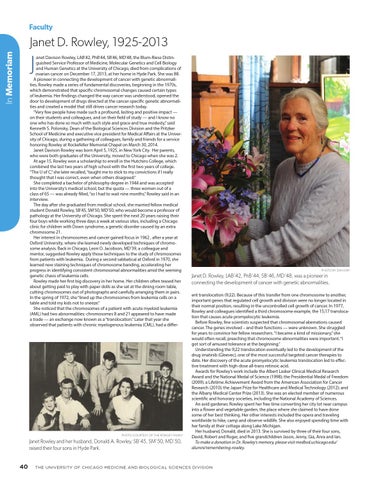Faculty
In Memoriam
Janet D. Rowley, 1925-2013 anet Davison Rowley, LAB’42, PhB’44, SB’46, MD’48, the Blum-Riese Distinguished Service Professor of Medicine, Molecular Genetics and Cell Biology and Human Genetics at the University of Chicago, died from complications of ovarian cancer on December 17, 2013, at her home in Hyde Park. She was 88. A pioneer in connecting the development of cancer with genetic abnormalities, Rowley made a series of fundamental discoveries, beginning in the 1970s, which demonstrated that specific chromosomal changes caused certain types of leukemia. Her findings changed the way cancer was understood, opened the door to development of drugs directed at the cancer-specific genetic abnormalities and created a model that still drives cancer research today. “Very few people have made such a profound, lasting and positive impact — on their students and colleagues, and on their field of study — and I know no one who has done so much with such style and grace and true modesty,” said Kenneth S. Polonsky, Dean of the Biological Sciences Division and the Pritzker School of Medicine and executive vice president for Medical Affairs at the University of Chicago, during a gathering of colleagues, family and friends for a service honoring Rowley at Rockefeller Memorial Chapel on March 30, 2014. Janet Davison Rowley was born April 5, 1925, in New York City. Her parents, who were both graduates of the University, moved to Chicago when she was 2. At age 15, Rowley won a scholarship to enroll in the Hutchins College, which combined the last two years of high school with the first two years of college. “The U of C,” she later recalled, “taught me to stick to my convictions if I really thought that I was correct, even when others disagreed.” She completed a bachelor of philosophy degree in 1944 and was accepted into the University’s medical school, but the quota — three women out of a class of 65 — was already filled, “so I had to wait nine months,” Rowley said in an interview. The day after she graduated from medical school, she married fellow medical student Donald Rowley, SB’45, SM’50, MD’50, who would become a professor of pathology at the University of Chicago. She spent the next 20 years raising their four boys while working three days a week at various sites, including a Chicago clinic for children with Down syndrome, a genetic disorder caused by an extra chromosome 21. Her interest in chromosomes and cancer gained focus in 1962 , after a year at Oxford University, where she learned newly developed techniques of chromosome analysis. Back in Chicago, Leon O. Jacobson, MD’39, a colleague and mentor, suggested Rowley apply those techniques to the study of chromosomes from patients with leukemia. During a second sabbatical at Oxford in 1970, she learned new staining techniques of chromosome banding, accelerating her progress in identifying consistent chromosomal abnormalities amid the seeming genetic chaos of leukemia cells. Rowley made her first big discovery in her home. Her children often teased her about getting paid to play with paper dolls as she sat at the dining room table, cutting chromosomes out of photographs and carefully arranging them in pairs. In the spring of 1972, she “lined up the chromosomes from leukemia cells on a table and told my kids not to sneeze.” She noticed that the chromosomes of a patient with acute myeloid leukemia (AML) had two abnormalities: chromosomes 8 and 21 appeared to have made a trade — an exchange now known as a “translocation.” Later that year she observed that patients with chronic myelogenous leukemia (CML), had a differ-
J
PHOTO COURTESY OF THE ROWLEY FAMILY
Janet Rowley and her husband, Donald A. Rowley, SB’45, SM’50, MD’50, raised their four sons in Hyde Park.
40
PHOTO BY DAN DRY
Janet D. Rowley, LAB’42, PhB’44, SB’46, MD’48, was a pioneer in connecting the development of cancer with genetic abnormalities. ent translocation (9;22). Because of this transfer from one chromosome to another, important genes that regulated cell growth and division were no longer located in their normal position, resulting in the uncontrolled cell growth of cancer. In 1977, Rowley and colleagues identified a third chromosome example, the 15;17 translocation that causes acute promyelocytic leukemia. Before Rowley, few scientists suspected that chromosomal aberrations caused cancer. The genes involved – and their functions — were unknown. She struggled for years to convince her fellow researchers. “I became a kind of missionary,” she would often recall, preaching that chromosome abnormalities were important. “I got sort of amused tolerance at the beginning.” Understanding the 9;22 translocation eventually led to the development of the drug imatinib (Gleevec), one of the most successful targeted cancer therapies to date. Her discovery of the acute promyelocytic leukemia translocation led to effective treatment with high-dose all-trans retinoic acid. Awards for Rowley’s work include the Albert Lasker Clinical Medical Research Award and the National Medal of Science (1998); the Presidential Medal of Freedom (2009); a Lifetime Achievement Award from the American Association for Cancer Research (2010); the Japan Prize for Healthcare and Medical Technology (2012); and the Albany Medical Center Prize (2013). She was an elected member of numerous scientific and honorary societies, including the National Academy of Sciences. An avid gardener, Rowley spent her free time converting her city lot near campus into a flower and vegetable garden, the place where she claimed to have done some of her best thinking. Her other interests included the opera and traveling worldwide to hike, camp and observe wildlife. She also enjoyed spending time with her family at their cottage along Lake Michigan. Her husband, Donald, died in 2013. She is survived by three of their four sons, David, Robert and Roger, and five grandchildren Jason, Jenny, Gia, Anra and Ian. To make a donation in Dr. Rowley’s memory, please visit medbsd.uchicago.edu/ alumni/remembering-rowley.
THE UNIVERSITY OF CHICAGO MEDICINE AND BIOLOGICAL SCIENCES DIVISION
